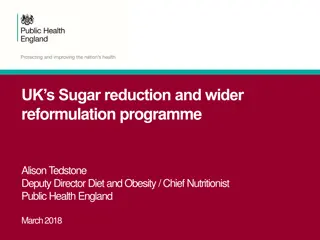Child Obesity Trends in Bradford District: NCMP 2021-22 Report
The National Child Measurement Programme (NCMP) data for 2021-22 in Bradford District shows concerning trends in child obesity. The prevalence of excess weight in reception-aged children has increased to 23.2%, surpassing the England average. Similarly, in Year 6 children, the prevalence of excess weight has risen to 41.5%, also above the national average. Despite a lower prevalence of overweight children in Reception (11.8%), there is still room for improvement. These findings highlight the ongoing challenge of childhood obesity in Bradford District, warranting targeted interventions and public health strategies.
Download Presentation

Please find below an Image/Link to download the presentation.
The content on the website is provided AS IS for your information and personal use only. It may not be sold, licensed, or shared on other websites without obtaining consent from the author.If you encounter any issues during the download, it is possible that the publisher has removed the file from their server.
You are allowed to download the files provided on this website for personal or commercial use, subject to the condition that they are used lawfully. All files are the property of their respective owners.
The content on the website is provided AS IS for your information and personal use only. It may not be sold, licensed, or shared on other websites without obtaining consent from the author.
E N D
Presentation Transcript
National Child Measurement Programme (NCMP) 2021-22 Public Health Intelligence Team The Joint Strategic Needs Assessment (JSNA) provides information on the current and future health and wellbeing needs of people in Bradford District visit https://jsna.bradford.gov.uk Department of Health & Wellbeing, Public Health
Introduction and the impact of the COVID-19 pandemic The National Child Measurement Programme (NCMP), established in 2006, collects annual measurements of the height and weight of over one million children in Reception (age 4-5 years) and Year 6 (age 10-11 years) in primary schools across England. The 2019 to 2020 NCMP data collection stopped in March 2020 when schools were closed due to the COVID-19 pandemic. 2021 to 2022 NCMP was the first data collection since the coronavirus COVID-19 pandemic that was unaffected by school closures and other public health measures. Therefore, 2021-22 data is compared to 2019-20 data where appropriate. There maybe instances where due to the smaller numbers measured in 2019-20 that comparisons in specific areas cannot be made, in particular deprivation. The participation rate in Bradford in 2021 to 2022 was 90.3% in Reception children and 88.5% for children in Year 6.
Excess Weight - Reception Prevalence of reception aged children who are overweight (including obesity) The prevalence of reception aged children who are overweight (including obesity) in the Bradford district has increased to 23.2% compared to 22.3% in 2019-20. . The prevalence of reception aged children who are overweight (including obesity) in the Bradford district is above the England average of 22.2%. Bradford has the 60th highest prevalence of reception aged children who are overweight (including obesity) out of the 150 local authorities in England
Excess Weight Year 6 Prevalence of Year 6 children who are overweight (including obesity) ** The prevalence of year 6 children who are overweight (including obesity) in the Bradford district has increased to 41.5% compared to 40.8% in 2019-20. The prevalence of year 6 children who are overweight (including obesity) in the Bradford district remains above national average; 37.8%. **interpret with caution - due to smaller number of children measured Bradford has the 42nd highest year 6 children who are overweight (including obesity) out of the 150 local authorities in England
Overweight - Reception Prevalence of reception aged children who are overweight The prevalence of reception aged children who are overweight in the Bradford district has increased to 11.8% compared to 11.5% in 2019- 20. . The prevalence of reception aged children who are overweight in the Bradford district is below the England average of 12.1%. Bradford has the 57th lowest prevalence of reception aged children who are overweight out of the 150 local authorities in England
Overweight Year 6 Prevalence of Year 6 aged children who are overweight ** The prevalence of Year 6 children who are overweight in the Bradford district has increased to 14.4% compared to 13.3% in 2019- 20. . The prevalence of Year 6 aged children who are overweight in the Bradford district is above the England average of 14.3%. **interpret with caution - due to smaller number of children measured Bradford has the 70th highest prevalence of reception aged children who are overweight out of the 150 local authorities in England
Severe Obesity - Reception Reception - Prevalence of severe obesity The prevalence of severe obesity in reception aged children in the Bradford district has increased to 3.5% compared to 2.7% in 2019- 20. The prevalence of severe obesity reception aged children in the Bradford district is above the England average of 2.9%. Bradford has the 41st highest reception aged children who are severely obese out of the 150 local authorities in England
Severe Obesity Year 6 Year 6 - Prevalence of severe obesity **The prevalence of severe obesity in year 6 children in the Bradford district has increased to 7.3% compared to 6.8% in 2019-20. The prevalence of severe obesity in year 6 children in the Bradford district remains above national average; 5.8%. **interpret with caution - due to smaller number of children measured Bradford has the 40th highest Year 6 children who are severely obese out of the 150 local authorities in England
Excess Weight Reception BMI status of reception children In 2021-22 Nearly three quarters of reception children had a BMI status in healthy weight range which has decreased compared to 2019-20 (76.2%) 1.8% reception children had a BMI status as underweight, an increase compared to 2019-20 (1.4%)
Excess Weight Year 6 BMI status of Year 6 children In 2021-22 56.2% of Year 6 children had a BMI status in healthy weight range in 2021-22 which has increased compared to 2019-20 (55.9%) 2.2% of Year 6 children had a BMI status as underweight, an decrease compared to 2019-20 (2.9%)
Excess Weight Gender - children who are overweight or very overweight Reception Year 6 There is a higher proportion of males compared to females in Reception that are either overweight or very overweight. There is a higher proportion of males compared to females in Year 6 that are overweight or very overweight.
Excess Weight Ethnicity Year 6 Reception The prevalence of excess weight in reception varies between different ethnic groups across the district from 19.8% to 35.6% (not including not stated ) ** The prevalence of excess weight in Year 6 varies between different ethnic groups across the district from 39.2% to 51.2% (not including not stated ) **due to smaller number of children measured in some ethnic groups, interpret with caution
Excess Weight Reception Deprivation 10.4 percentage points Most deprived quintile Least deprived quintile The proportion of Reception children that are classified overweight or very overweight within each quintile ranges from 14.7% to 25.1%. Deprivation Gap In 2021/22 the gap between the most and least deprived quintiles within the district was 10.4 percentage points Due to smaller numbers measured in 2019-20 comparisons are not made
Excess Weight Year 6 Deprivation 15.8 percentage points Most deprived quintile Least deprived quintile Deprivation Gap The proportion of Year 6 children that are classified overweight or very overweight increases as deprivation increases In 2021/22 the gap between the most and least deprived quintiles within the district was 15.8 percentage points Due to smaller numbers measured in 2019-20 comparisons are not made
Ward distribution: 3 year data combined Reception Prevalence of excess weight across the wards of Bradford District ranges from 17.6% to 26.9% Ilkley has the lowest proportion of 4-5 year olds with excess weight Eccleshill has the highest proportion of 4-5 year olds with excess weight
Ward distribution: 3 year data combined Year 6 Prevalence of excess weight across the wards of Bradford District ranges from 19.7% to 45.2%. Ilkley has the lowest proportion of Year 6 children with excess weight Keighley Central has the highest proportion of Year 6 children with excess weight























